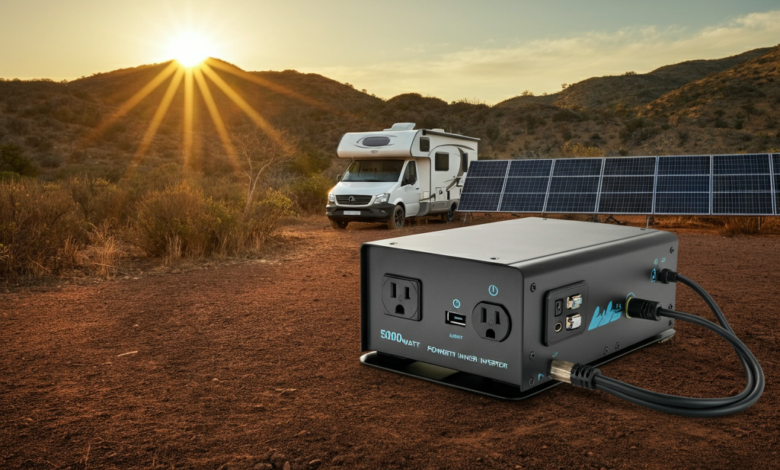Your Guide to 5000-Watt Power Inverters for Off-Grid Living and Adventures

Living off the grid, traveling in your van, or exploring the country in an RV is all about freedom and independence. But whether you’re powering your lights, running appliances, or charging devices, reliable electricity is still a must. That’s where a 5000-watt power inverter comes in.
This guide will help you understand the importance of these devices, what to look for when purchasing one, and how to make the most of your power needs for off-grid living or life on the road.
What is a 5000-Watt Power Inverter, and Why Do You Need One?
A power inverter is a device that converts direct current (DC) electricity stored in sources like batteries into alternating current (AC) electricity, which is what your appliances and devices use. A 5000-watt inverter can handle heavy power demands, making it perfect for running high-powered appliances like refrigerators, air conditioning units, and power tools.
For off-grid living, van lifers, and RV enthusiasts, a 5000-watt power inverter ensures you don’t have to compromise on comfort or function. Whether you’re running kitchen appliances, charging multiple devices, or powering equipment for work, this device transforms your power source into usable energy for modern living.
Key Features to Consider When Choosing a 5000-Watt Power Inverter
Not all power inverters are created equal. To make sure you choose the right model for your needs, keep an eye on these essential features:
1. AC Outlets
The number of available AC outlets determines how many appliances you can run simultaneously. Look for inverters with multiple outlets to power your key devices. Some models may also include split-phase outputs, which are especially useful for more demanding appliances.
2. USB Ports
For charging smaller devices like smartphones, tablets, and cameras, USB ports are incredibly handy. Having a mix of AC outlets and USB ports offers flexibility and convenience, so you can keep all your essentials powered up.
3. Remote Control Operation
Many inverters come with remote control functionality, allowing you to turn the unit on or off or monitor performance without needing direct access to the main unit. This feature is especially useful in RVs or vans where inverters may be tucked away in tight spaces.
4. Built-in Safety Features
Good power inverters prioritize safety. Look for models with built-in protections against overloads, short circuits, overheating, and low battery voltage shutdown. These features safeguard your inverter, connected devices, and your battery system.
5. Pure Sine Wave Output
Choose an inverter that provides pure sine wave output for stable and clean power. These are compatible with sensitive electronics like laptops, ensuring they operate efficiently without risk of damage.
Top Uses of a 5000-Watt Power Inverter for Off-Grid Living and Adventures
A high-powered inverter opens a world of possibilities for your mobile or off-grid lifestyle. Here are some of the key uses to consider.
Off-Grid Living
For those living off-grid, a 5000-watt inverter can run most household appliances, including refrigerators, washing machines, and even electric stoves, making it easier to enjoy life in remote locations without sacrificing essential comforts.
Van Life
Van lifers often use inverters to power portable fridges, induction cooktops, and entertainment systems. With this level of power, it’s also possible to run gear for remote working, like laptops, external monitors, and Wi-Fi routers.
RV Adventures
This inverter ensures RVers can power larger AC units, kitchen appliances, and entertainment devices simultaneously, creating a truly mobile home experience.
Work Sites and Tools
Need to power heavy-duty tools while working off the grid? A 5000-watt inverter can handle saws, drills, and other equipment, making it perfect for remote projects.
How to Install a Power Inverter Safely
Proper installation is critical for maximizing performance and ensuring safety. Here’s a simplified guide to help you set up your system properly.
Step 1. Choose the Right Batteries
Make sure you pair your inverter with an appropriately sized battery bank. Power inverters of this size demand significant energy, so a reliable battery setup, like deep-cycle batteries or lithium-ion batteries, is essential.
Step 2. Use Proper Wiring
Always use heavy-duty cables to connect the inverter to your battery bank. Consult the inverter manual for specific wiring recommendations to handle the high current load safely.
Step 3. Install a Fuse or Breaker
Install a fuse or circuit breaker between the inverter and battery to protect your system from short circuits or overloads.
Step 4. Ground the System
Grounding your inverter minimizes shock hazards and improves system safety. Confirm the proper grounding process in the manual that accompanies your device.
Step 5. Mount the Unit Securely
Install the inverter in a well-ventilated, dry, and easily accessible location to avoid overheating and ensure maintenance is straightforward.
Top 5000-Watt Power Inverters on the Market
If you’re ready to purchase your inverter, consider these highly-rated options for their performance, reliability, and features.
1. AIMS Power 5000-Watt Pure Sine Wave Power Inverter
- Offers clean, stable power for sensitive electronics.
- Includes a remote and integrated cooling fan.
- Price range: $$$
2. Go Power! GP-SW5000-12 Pure Sine Wave Power Inverter
- Ideal for RVs and larger systems.
- Extensive safety features and great surge capability.
- Price range: $$$
3. WZRELB 5000-Watt Power Inverter
- Budget-friendly option.
- Modified sine wave output, suitable for standard appliances.
- Price range: $$
Tips for Maintaining Your Power Inverter
Regular maintenance will ensure maximum longevity and reliability for your investment.
- Keep It Clean: Dust and debris can affect performance, so clean your inverter periodically with a dry cloth or canned air.
- Check Connections: Ensure your cables remain secure and inspect for signs of corrosion or damage.
- Avoid Overloading: Only connect appliances that fall within the wattage limits to prevent unnecessary stress on the system.
- Monitor Battery Health: A healthy battery bank ensures the inverter functions at maximum efficiency.
Troubleshooting Common Issues
Problem 1: The inverter doesn’t turn on.
- Check battery voltage and ensure cables are properly connected.
Problem 2: Appliances fail to power up.
- Ensure your total connected load doesn’t exceed the inverter’s capacity.
Problem 3: Overheating or sudden shutdown.
- Verify there’s proper ventilation around the inverter and reduce the power load if necessary.
The Future of Power Inverters
The future of power inverters looks bright as innovations continue to improve efficiency, size, and versatility. Advancements like smart inverters and remote monitoring allow users even greater control, while eco-conscious designs ensure sustainability for off-grid living.



